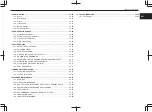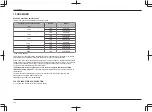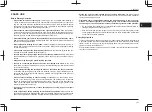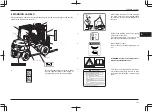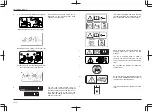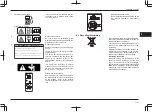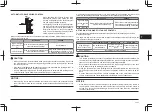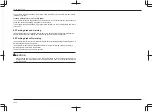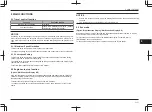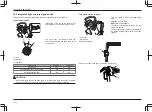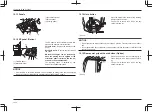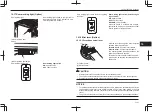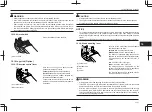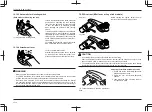
7 SAS FUNCTION
en‐13
AUTOMATIC FORK LEVELING CONTROL
When operating the tilt lever forward while
pressing the tilt lever knob switch, the forks
will stop automatically at the horizontal posi
tion (the mast positioned vertically).
After stopping the forks at the horizontal posi
tion with the tilt lever knob switch pressed,
you may want to tilt the forks further forward.
Return the tilt lever to the neutral position
once. Then, after releasing the tilt lever knob
switch, operate the tilt lever again.
When operating the tilt lever from the backward to forward position while pressing the tilt lever
knob switch, the forks will:
Not loaded
Loaded
High Lift Height
(Over 6 feet or 2
m)
Stop at the horizontal position (with
mast positioned vertically)
Not tilt forward
Low Lift Height
Stop at the horizontal position (with
mast positioned vertically)
Stop at the horizontal position (with
mast positioned vertically) or up to
1° backward depending on the load
CAUTION
•
When you move the tilt lever forward while pressing the tilt lever knob switch, with a load
at a high lift height, the mast will stop moving suddenly. Avoid such operation, because
the truck may tip over.
•
If the truck is equipped with an attachment, do not use automatic fork leveling with an el
evated load, and the engine running at high RPM.
•
A heavy attachment may affect a lift truck equipped with automatic fork leveling control.
Consult with the Toyota dealer before installing this type of attachment.
NOTICE
•
When moving the tilt lever backwards, the forks will not stop at the horizontal position
even if the tilt lever knob switch is pressed (except trucks equipped with Mini lever or Joy
stick).
On lift trucks equipped with Mini lever or Joy stick (Option): When operating the tilt lever from
forward to backward position while pressing the tilt lever knob switch, the forks will:
Not Loaded
Loaded
High Lift Height
(Over 6 feet or 2
m)
Stop at the horizontal position (with
mast vertically positioned)
Stop at the horizontal position (with
mast positioned vertically) or up to
1° backward depending on the load
Low Lift Height
ACTIVE MAST FORWARD TILT ANGLE CONTROL
This function automatically limits the forward tilt angle of the mast depending on the load
weight and lift height.
The angle at which the mast can be tilted forward is automatically controlled according to the
load weight and lift height as follows:
Light Load (no load)
Medium Load
Heavy Load
High Lift Height
(Over 6 feet or 2 m)
No limitation for for
ward tilt angle
Forward tilt angle lim
ited from 1° to 5° de
grees
Forward tilt angle lim
ited to 1° degree
Low Lift Height
No limitation for forward tilt angle
CAUTION
•
This feature is intended to enhance the stability of the forklift under certain conditions, but
cannot prevent the forklift from tipping forward or the load from falling off under all circum
stances. You must continue to use caution when operating the forklift.
•
Never tilt the mast beyond its vertical position with a load at a high lift height, or the truck
may tip forward, losing its stability forward or backward.
•
When you lift a load from a low lift height with the mast tilted forward, the active mast for
ward tilt angle control does not work. Avoid such operation, because the truck may tip for
ward.
•
A heavy attachment may affect a lift truck equipped with active mast forward tilt angle
control. Consult with the Toyota dealer before installing this type of attachment.
NOTICE
•
When forks are at the maximum lift height, high pressure (relief pressure) may remain in
the lift cylinder. This will cause the truck to detect that it has a heavy load even if there is
no load. As a result, the tilt forward angle is limited. In such case, lower the mast slightly
to tilt the mast forward.
7
Содержание 40--8FD35N
Страница 92: ...19 TRUCK DIMENSIONS en 93 19...


